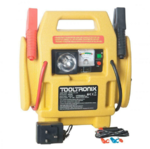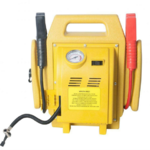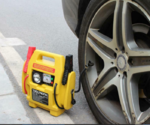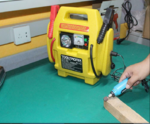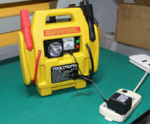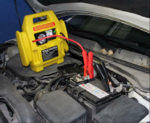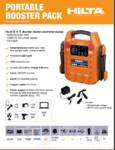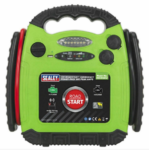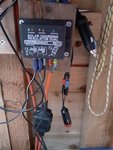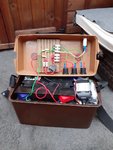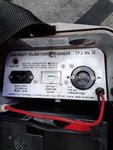wildebus
Full Member
- Messages
- 7,783
There is a discussion on Jagmanxs thread about extra power options that touched on "battery in a box" type setups.
I thought I would post some comments and pictures of what I think is a good low-cost way to use a old spare battery (or a new one bought for the purpose for that matter) in an easy, reliable and, most importantly, safe way.
#1 - Get a Battery Box.
Different sizes are available to suit whatever battery you have or are looking to get. The boxes tend to be similar in height and depth and only really vary in length.
#2 - Fit External Sockets and Connectors.
The things I fit are as follows:
Voltmeter - to keep an eye on the Battery State
USB Sockets - Charging phones, etc. A handy space-saver can be to use a Combo Voltmeter + USB Socket
12V Socket - usual accessories and a way for lower (<10A typically) charging or supply
Anderson Plug - connection for higher current charging or supply - upto 50A
I fit these to the lid of the battery box - Anderson Plug one side and the others on the other. I also fit a Switch so I can turn off the Voltmeter and USB sockets to save power when not in use.

12V, USB, Voltmeter and Switch (covers taped up for photo)
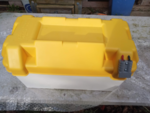
Anderson Plug
#3 - Internal Cabling
Next Step is to wire up the Battery to the connectors
On the lid run Ground and +12V wires of suitable gauge.
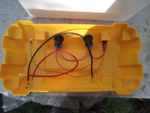
The +12V wires will go to fuse holders and the Ground will go to the battery
And on the box side, fuse Holders and the other side of the +12V cables, plus battery post terminals as appropriate
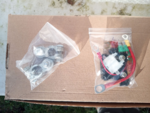
For the High Current Anderson Plugs, I use a midi-fuse Fuse Holder with mini-ANL fuse, and for the other circuits (USB, Volt and 12V Socket) I use a standard Spade Fuse holder.
This setup will give you a portable battery that can be used without having to mess around with croc clips and the like every time as it is all cabled up securely internally, no exposed terminals and the same connections as your regular ones fitted in the motorhome/campervan.
#4 - Charging
The 12V Socket and Anderson Plugs are by nature bi-directional so can be used for both Supply AND Charging.
The cables that can be used include the following:
12V - 12V Lead

One end goes in the 12V socket in the Battery Box; the other to a 12V socket in the van. If the Leisure Battery voltage is higher than the Portable Battery (if say the Split Charge is active), then the Portable Battery will get charged. If the Portable Battery voltage is higher than the Leisure Battery then power will transfer from the Portable Battery to the Leisure Battery and help supplement that supply via the 12V-12V cable.
12V Socket - Croc Clips

Another handy lead is the 12V Socket to Croc Clips. This can be used with the 12V-12V lead to connect direct to the battery and could be used for example to put some charge back into a low Starter Battery (not suitable for jump starting though!)
Anderson - 12V Plug

This is a handy lead as it allows the Portable Battery to be connected to the van for charging or to provide a boost, whilst keeping the 12V socket in the Battery Box free for use.
Having an Anderson Plug connection gives a lot of flexibility. You could have an Inverter with the DC inputs fitted with an Anderson Plug and connect to the battery. Or like in the example below, a Battery Charger with an Anderson Plug on the DC outputs to charge up the battery (maybe when left in the garage between trips?)
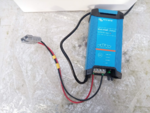
#5 - Example Setup
This is a photo of the Battery Box I use myself in a Gazebo at shows.

Same setup as the bigger box in the first photos, but fitted with a 75Ah battery that will fit in a medium-size box
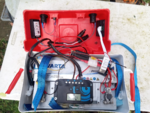
I also fitted a Solar Controller (in this case a spare 20A PWM unit I had), wired permanently to the battery and with the inputs via a pair of MC4 connectors (as used by the majority of Solar Panels), fed out the side of the lid so easily accessible.
(In the one above, I also fitted a couple of different battery monitors at each end to demonstrate. Just ignore those )
)
Is it as smart as one of the "Battery Generators" or "Solar Generators"? Absolutely not, but I think this approach provides something just as capable but for a significant saving in cost
Is it worth doing this over just having a loose battery and a pair of jump leads? Absolutely yes, as you have a setup that is instantly usable in lots of different ways, with secure connections that won't drop off and no exposed terminal posts
Can you do this yourself? Again absolutely yes and with minimal tools and at low cost
I thought I would post some comments and pictures of what I think is a good low-cost way to use a old spare battery (or a new one bought for the purpose for that matter) in an easy, reliable and, most importantly, safe way.
#1 - Get a Battery Box.
Different sizes are available to suit whatever battery you have or are looking to get. The boxes tend to be similar in height and depth and only really vary in length.
#2 - Fit External Sockets and Connectors.
The things I fit are as follows:
Voltmeter - to keep an eye on the Battery State
USB Sockets - Charging phones, etc. A handy space-saver can be to use a Combo Voltmeter + USB Socket
12V Socket - usual accessories and a way for lower (<10A typically) charging or supply
Anderson Plug - connection for higher current charging or supply - upto 50A
I fit these to the lid of the battery box - Anderson Plug one side and the others on the other. I also fit a Switch so I can turn off the Voltmeter and USB sockets to save power when not in use.

12V, USB, Voltmeter and Switch (covers taped up for photo)

Anderson Plug
#3 - Internal Cabling
Next Step is to wire up the Battery to the connectors
On the lid run Ground and +12V wires of suitable gauge.

The +12V wires will go to fuse holders and the Ground will go to the battery
And on the box side, fuse Holders and the other side of the +12V cables, plus battery post terminals as appropriate

For the High Current Anderson Plugs, I use a midi-fuse Fuse Holder with mini-ANL fuse, and for the other circuits (USB, Volt and 12V Socket) I use a standard Spade Fuse holder.
This setup will give you a portable battery that can be used without having to mess around with croc clips and the like every time as it is all cabled up securely internally, no exposed terminals and the same connections as your regular ones fitted in the motorhome/campervan.
#4 - Charging
The 12V Socket and Anderson Plugs are by nature bi-directional so can be used for both Supply AND Charging.
The cables that can be used include the following:
12V - 12V Lead

One end goes in the 12V socket in the Battery Box; the other to a 12V socket in the van. If the Leisure Battery voltage is higher than the Portable Battery (if say the Split Charge is active), then the Portable Battery will get charged. If the Portable Battery voltage is higher than the Leisure Battery then power will transfer from the Portable Battery to the Leisure Battery and help supplement that supply via the 12V-12V cable.
12V Socket - Croc Clips

Another handy lead is the 12V Socket to Croc Clips. This can be used with the 12V-12V lead to connect direct to the battery and could be used for example to put some charge back into a low Starter Battery (not suitable for jump starting though!)
Anderson - 12V Plug

This is a handy lead as it allows the Portable Battery to be connected to the van for charging or to provide a boost, whilst keeping the 12V socket in the Battery Box free for use.
Having an Anderson Plug connection gives a lot of flexibility. You could have an Inverter with the DC inputs fitted with an Anderson Plug and connect to the battery. Or like in the example below, a Battery Charger with an Anderson Plug on the DC outputs to charge up the battery (maybe when left in the garage between trips?)

#5 - Example Setup
This is a photo of the Battery Box I use myself in a Gazebo at shows.

Same setup as the bigger box in the first photos, but fitted with a 75Ah battery that will fit in a medium-size box

I also fitted a Solar Controller (in this case a spare 20A PWM unit I had), wired permanently to the battery and with the inputs via a pair of MC4 connectors (as used by the majority of Solar Panels), fed out the side of the lid so easily accessible.
(In the one above, I also fitted a couple of different battery monitors at each end to demonstrate. Just ignore those
Is it as smart as one of the "Battery Generators" or "Solar Generators"? Absolutely not, but I think this approach provides something just as capable but for a significant saving in cost
Is it worth doing this over just having a loose battery and a pair of jump leads? Absolutely yes, as you have a setup that is instantly usable in lots of different ways, with secure connections that won't drop off and no exposed terminal posts
Can you do this yourself? Again absolutely yes and with minimal tools and at low cost

